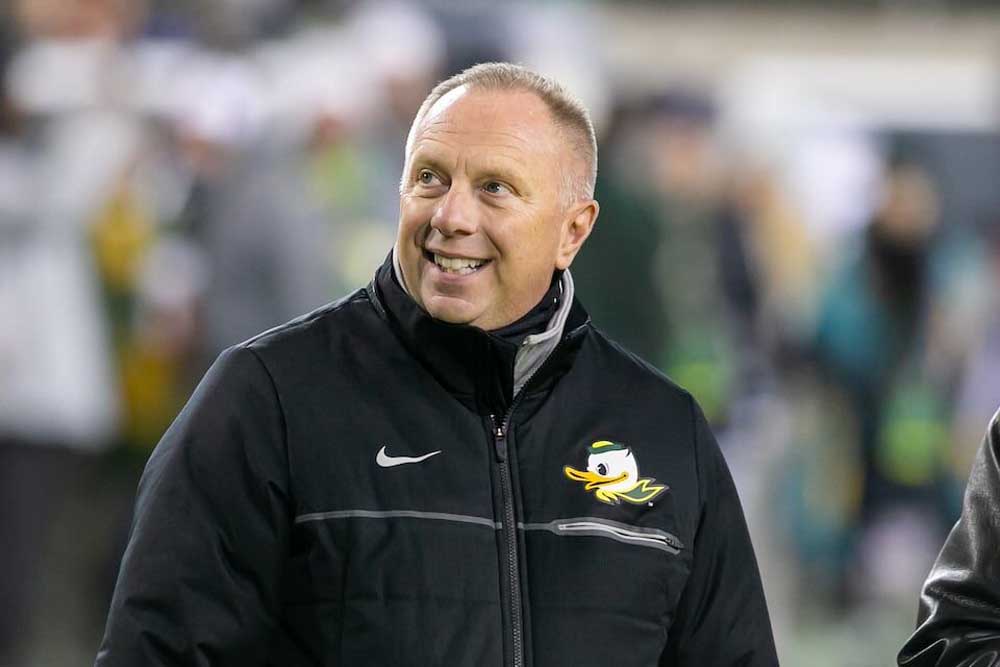Oregon AD Mullens speaks on uncertainties ahead in Big Ten
Published 5:35 pm Monday, July 22, 2024

- Oregon athletic director Rob Mullens looks on prior to a Ducks football game at Autzen Stadium in 2022.
EUGENE — Nearly a year after the Oregon Ducks made the historic decision to jump from the Pac-12 to the Big Ten, UO athletic director Rob Mullens acknowledged he still experiences some heartache over the breakup of the century-old conference.
“Sure I do,” Mullens said.
Some may find a hint of irony in that.
There are those who will forever view Oregon and its decision-makers as a villain, the classic black hat, in the shake-up that scrambled college sports in the American West and brought rival Oregon State to its knees.
Fair?
“I think the University of Oregon, at every level, did everything we could for a long period of time, to find a way to continue as the Pac-10,” Mullens told The Oregonian/OregonLive. “And it wasn’t possible.”
People in this state might always debate the righteousness of Oregon’s departure from the Pac-12. But with Oregon’s official welcome to the Big Ten now just days away, Mullens said the decision was about building on the growth and exposure the university has experienced over the past three decades, adding that he “felt an incredible amount of pressure to make sure that Oregon … is in a position to remain at the level we all expect to be.”
“We’re very proud of the history and tradition and our role in the PCC, the Pac-8, Pac-10 and the Pac-12,” Mullens said. “But this is a competitive landscape. If we don’t spend our time thinking about how we’re going to compete in the future … you’ll fall way behind.”
For anyone who says Oregon did it for money and cared more about being a national — or global — brand than it did than scabbing together a diminished version of the Pac-12, well, yeah.
“Particularly given that 85% of our student-athletes are out of state, our brand is extremely, extremely important,” Mullens said. “What are we going to do strategically to allow ourselves to compete with a 58,000-seat stadium against teams who have 102,000? You can do the simple math on that.
“So we have to spend considerable time thinking strategically.”
A quick refresher of how the Ducks got here, on the doorstep of becoming freshman members of a new conference:
With the Pac-12 already down to nine members, then-Commissioner George Kliavkoff proposed a media rights deal with Apple that fell short of many people’s expectations — both in dollar figure and in terms of visibility.
Not only did the the Pac-12 proposal come in well below the annual payout for schools in the Big 12, a number Kliavkoff pledged to meet, but the agreement included no carveouts for games on linear television, a major sticking point for heavily-watched football programs like Oregon.
“In this new world, it was going to be virtually impossible to compete at the highest level,” Mullens said.
Oregon and Washington jumped for a 50% media rights payout for six years from the Big Ten.
Speaking in his office last week, Mullens was surrounded by decor that helped tell the story.
Displayed behind his desk were ballcaps from the Ducks’ final Pac-12 championships and also one from the Big Ten Network.
A toe in one, a foot in the other.
That transition is almost complete. The Big Ten’s football media days are this week in Indianapolis and the four schools will officially join the conference on Aug. 2 — two days shy of the anniversary of the morning the Pac-12 crumbled. The Ducks, who will likely open the season with a top-five ranking, will play their first game in the Big Ten in the Rose Bowl on Sept. 28 against UCLA — call it a soft launch — before hosting Michigan State on Oct. 4 and Ohio State a week later.
“When you reflect on it,” Mullens said, “a lot has happened in a very short period of time. … It’s been a windy road, an intense period, and it is here.”
Football might be the program to least feel the effects of the move. The Ducks have a rising superstar for a coach in Dan Lanning, a top recruiting class and legitimate national championship aspirations.
Among the changes that come with the move, steeper travel costs are inevitable.
While Mullens said his department is still finalizing budget numbers, the initial expectation was that the school would incur about $4 million in added travel expenses playing in a coast-to-coast conference. Across the sports competing in the Big Ten, Mullens said, athletes will experience a rough average of 3.5 more travel days per year.
Mullens said last week that he was optimistic the department would be able to come in below that $4 million figure, which would still represent a significant increase from the approximately $10.4 million that an athletic department spokesperson said Oregon’s teams spent on travel in 2023-24.
Oregon’s overall athletic budget is set to increase by $17.5 million from $145 million last year to $162.5 million this year, according to the spokesperson.
Mullens pointed to rising costs of scholarships, PERS, cost-of-living raises and inflation as other things reflected in the higher budget.
“I know 17 (million) looks like a lot, but when you look across, what are some special added expenses (in the Big Ten)? There aren’t many,” Mullens said. “That travel piece will be one part of it, but the rest of it is just kind of customary operational increases.”
The last year has required rethinking how athletic departments across the country operate as sports enterprises, a conversation that comes amid a tidal wave of change that almost makes realignment seem quaint. The House vs. NCAA settlement could require schools to provide an estimated $21.5 million annually to athletes in revenue sharing separate from NIL, a fundamental change to the way athletic departments operate.
“There’s still some huge questions that remain around that settlement,” Mullens said. “Obviously, we’re building multiple plans based on how those questions get answered. … It’s a whole new frontier.”
By the time those questions, get answered, Oregon should be used to new frontiers. They’re about to embark on one.
Asked what excites him most about the Big Ten, Mullens leaned on the same kind of romance that has others wishing things could have stayed the same.
“One of the great things about college athletics is just the pageantry and the passion,” he said. “And so when you go to Nebraska to play volleyball, when you go to Wisconsin to play volleyball, obviously the Big House, the Horseshoe, Happy Valley. … Everybody understands what that’s going to look like.”
He referenced a quote from former Oregon defensive end Casey Rogers, who previously played at Nebraska and said last year that “the cathedrals of college football are in the Big Ten.”
“But,” Mullens said, “I think that’s going to extend beyond football. So, I’m looking forward to seeing some of the passion that exists in the Upper Midwest.”






